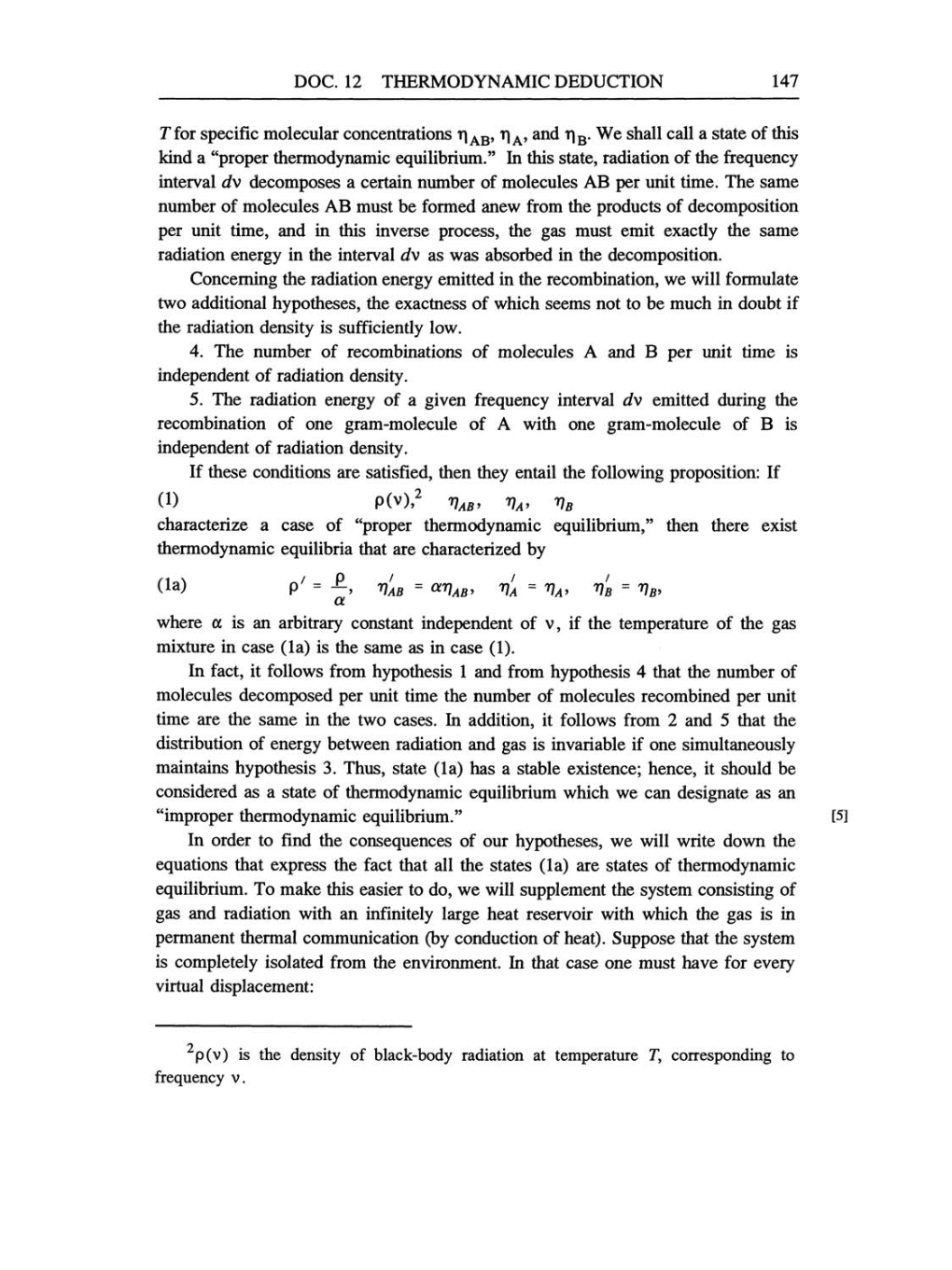DOC.
12
THERMODYNAMIC DEDUCTION
147
T
for
specific
molecular concentrations
nAB, nA,
and
nB.
We shall call
a
state
of this
kind
a "proper thermodynamic equilibrium."
In
this
state,
radiation of the
frequency
interval dv
decomposes
a
certain
number
of molecules AB
per
unit time. The
same
number
of
molecules AB
must
be formed
anew
from the
products
of
decomposition
per
unit
time,
and in this inverse
process,
the
gas
must
emit
exactly
the
same
radiation
energy
in
the interval dv
as was
absorbed in the
decomposition.
Concerning
the radiation
energy
emitted
in the
recombination,
we
will formulate
two
additional
hypotheses,
the
exactness
of
which
seems
not to
be much in doubt
if
the
radiation
density
is
sufficiently
low.
4.
The number of
recombinations
of molecules
A and
B
per
unit time
is
independent
of
radiation
density.
5.
The
radiation
energy
of
a
given frequency
interval dv emitted
during
the
recombination
of
one gram-molecule
of
A
with
one gram-molecule
of B is
independent
of
radiation
density.
If these
conditions
are
satisfied,
then
they
entail the
following proposition:
If
(1)
P(v),2
nAB,
nA, nB
characterize
a
case
of
"proper thermodynamic equilibrium,"
then there exist
thermodynamic equilibria
that
are
characterized
by
(1a)
p'
=
-.
Vab =
xVab
Va =
VA
Vb =
VB
a
where
a
is
an
arbitrary
constant
independent
of
v,
if the
temperature
of the
gas
mixture in
case
(1a)
is the
same as
in
case (1).
In
fact,
it
follows from
hypothesis
1
and from
hypothesis
4
that the number of
molecules
decomposed
per
unit time
the number of molecules recombined
per
unit
time
are
the
same
in the
two
cases.
In
addition,
it
follows from
2
and
5
that the
distribution of
energy
between radiation and
gas
is invariable if
one
simultaneously
maintains
hypothesis
3.
Thus,
state
(1a)
has
a
stable
existence; hence,
it should be
considered
as a
state
of
thermodynamic equilibrium
which
we can designate as an
"improper thermodynamic equilibrium."
[5]
In order
to
find
the
consequences
of
our
hypotheses,
we
will write down the
equations
that
express
the fact that all the
states
(1a) are
states
of
thermodynamic
equilibrium.
To make this easier
to
do,
we
will
supplement
the
system consisting
of
gas
and radiation with
an
infinitely large
heat reservoir with which the
gas
is
in
permanent
thermal
communication
(by
conduction
of
heat). Suppose
that the
system
is
completely
isolated from the environment. In that
case one
must
have for
every
virtual
displacement:
2
p(v) is
the
density
of
black-body
radiation at
temperature
T,
corresponding
to
frequency
v.
